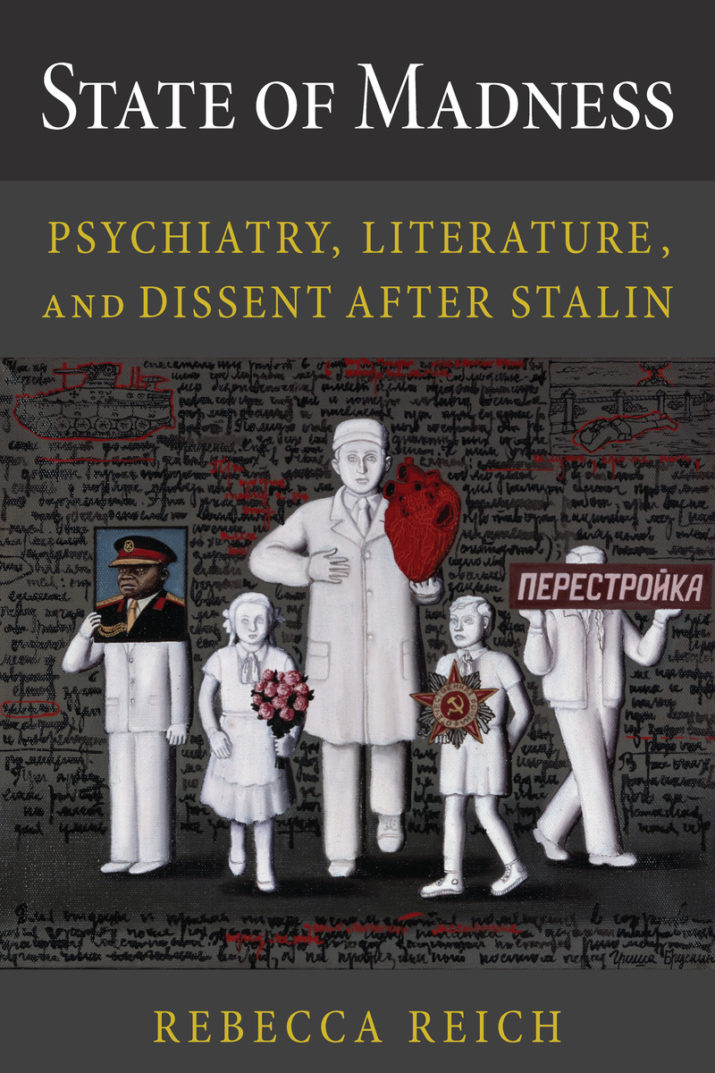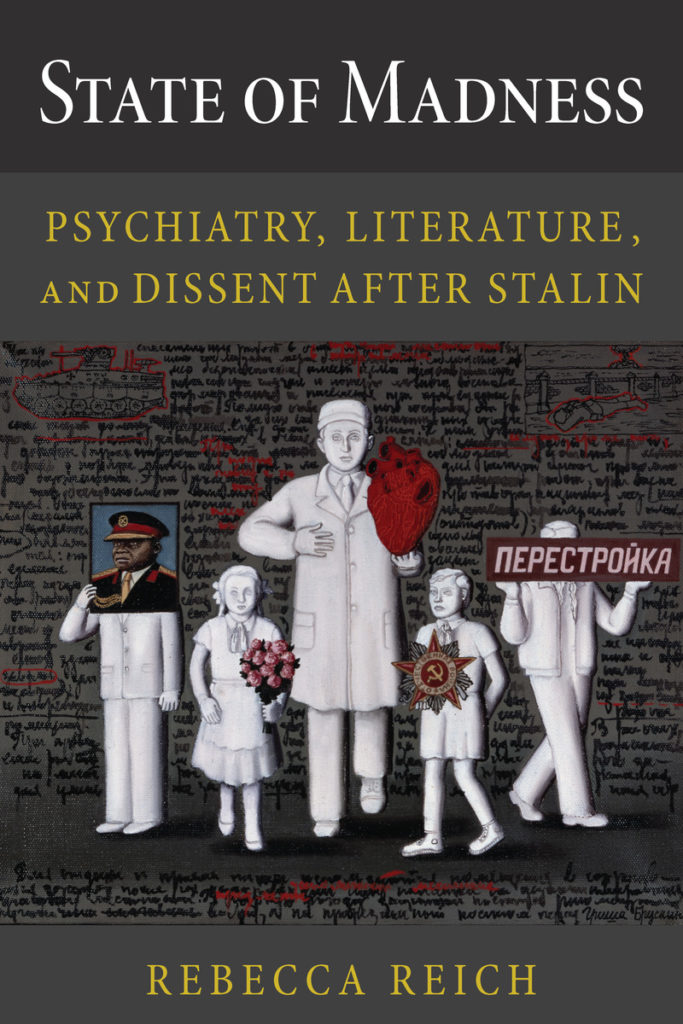

In the decades following Joseph Stalin’s death in 1953, the abuse of psychiatric medicine for political purposes in the Soviet Union garnered worldwide attention and opprobrium. Dissidents and nonconformist intellectuals, confined to mental hospitals with syndromes such as “sluggish schizophrenia,” “delusions of reformism,” and “litigiousness,” circulated reports of their mistreatment via both domestic samizdat and foreign tamizdat self-publishing channels. By the late 1970s, the systematic conflation of inakomyslie (“thinking differently”) with insanity had been so thoroughly documented that the World Psychiatric Association censured and moved to expel the USSR, prompting the Soviet delegation to preemptively resign in 1983. A wealth of post-Soviet memoirs and scholarly works have subsequently investigated the medical, political-institutional, and Cold War dimensions of punitive psychiatry.
In State of Madness: Psychiatry, Literature, and Dissent after Stalin, Rebecca Reich takes a novel approach to this well-worn topic. Departing from more overtly political interpretations, Reich emphasizes the “aesthetic dimension” (26) of punitive psychiatry, examining the cultural nexus between Soviet diagnostic practices and literary texts about madness, produced by dissenting writers who “used their narratives to depathologize themselves and pathologize both society and the state.” (15) By exposing the subjective, aestheticized underpinnings of an ostensibly objective science, she argues, dissenting writers not only challenged the state’s authority to define who was and was not sane, but in fact undermined the broader truth claims of Marxist-Leninist ideology and the Soviet project’s pretensions to represent an alternative, socialist modernity.
Reich contrasts dissident responses to punitive psychiatry in the USSR with the wave of anti-psychiatric writing that emerged simultaneously in the West during the early 1960s, most notably Michel Foucault’s Madness and Civilization (1961). “Like Foucault,” she writes, “dissenters criticized Soviet psychiatry for isolating and silencing those individuals who contested the state’s authority.” (13) However, where Foucault’s arguments about the discursive construction of madness called into question the discipline of psychiatry as a whole, amounting to a critique of liberal modernity’s enthronement of professional expertise, Soviet dissenters were more likely to view political abuse of psychiatry as symptomatic of rampant authoritarianism and disregard for scientific objectivity. For them, “it was precisely by building a more liberal society that citizens would mitigate and possibly eradicate abuse.” (66)
Reich likewise distinguishes between dissidents—radical activists who “challenged the political status quo in word and deed”—and dissenters, a broader group running the gamut from those harboring private doubts about Soviet orthodoxy to writers “who voiced their thoughts in literary form but did not engage in active protest.” (4) It is this latter group that State of Madness foregrounds. While the first half of the book maintains a rough balance between historical and literary analysis, the second half focuses nearly exclusively on three dissenting authors: Joseph Brodsky, Andrei Siniavskii, and Venedikt Erofeev. The result is a rich interdisciplinary study that, while at times disjointed, succeeds more often than not in weaving together literary and nonliterary evidence to paint a portrait of how Soviet dissenters responded to punitive psychiatry.
Chapter 1 examines what Reich calls the “art of diagnosis,” a term capturing the subjective dimension of psychiatric treatment that Soviet doctors celebrated as a professional prerogative, but dissenters decried as a pretext for abuse. If, as the doyen of Soviet psychiatry Andrei Snezhnevskii remarked in 1968, diagnosing mental disorders was a “creative act” depending in part on “the personal qualities of the physician,” (27) this both enabled manipulation for political purposes and provided dissenters with justification for challenging psychiatric medicine on artistic grounds. Here, Reich draws a parallel with the official aesthetic of Socialist Realism, going so far as to suggest that Soviet psychiatrists unconsciously emulated Socialist Realist novels in their projection of a monologic discourse and construction of a “therapeutic master plot.” (51) More convincing is her analysis of how psychiatrists drew on state-sanctioned aesthetics in evaluating their patients’ artworks, treating deviations from Socialist Realism’s representational norms as evidence of mental debilitation.
Chapter 2 chronicles political activists’ experiences with Soviet psychiatric medicine. Punitive psychiatry, Reich explains, functioned “as a discursive trap that tightened as patients struggled with it” (61)—the more one affirmed one’s soundness of mind, the more this was taken for evidence of precisely the opposite. Dissidents developed a variety of strategies in response. The poet and mathematician Aleksandr Vol’pin, for example, preached disengagement from the pseudo-literary discourse of psychiatry, advocating instead a strictly rational-legal stance in interactions with diagnosticians. Others, such as Vladimir Bukovskii and Semen Gluzman, believed legal haranguing would only expedite the process of having oneself declared insane. Their “Manual on Psychiatry for Differently Thinking People,” published as samizdat in 1974, advocates limited engagement with psychiatric discourse, with the pragmatic goal of conveying sanity through one’s words and actions: “Do not show any interest in contemporary ‘modern’ art or, especially, any understanding of it. You do not confine your free time to autistic pursuits such as reading, gardening, contemplation of nature, and works of art.” (90)
What these responses have in common, both with each other and with the nonconformist literature Reich discusses, is a concern to dialogize the monologism of psychiatric discourse. In other words, whereas Soviet psychiatrists posited treatment as a one-way street (what Foucault calls “a monologue of reason about madness”), political dissidents and dissenting writers sought to reinsert their own voices, or those of their literary creations, into diagnostic interactions. Reich’s primary interpretive category is “authority,” understood as both power—to pronounce a diagnosis of madness, to enforce a course of treatment—and as authorship (author-ity), the right to claim discursive control over one’s own narrative. For dissenters during the post-Stalin period, subverting the “diagnostic authority” of Soviet psychiatrists entailed not only contesting medical expertise and objectivity, but also doctors’ authorial claims over the psychiatric narratives of their patients.
Chapters 3, 4, and 5 shift gears to scrutinize the writings of Brodsky, Siniavskii, and Erofeev, all major dissenting authors who probed the precarious boundary between creativity and madness. For Brodsky, the Marxist dictum “existence determines consciousness” revealed the state’s creative myopia; his verse cycles enacted an experimental inversion of this thesis, testing the ability of poetic consciousness to determine existence while retaining its grip on reality. Siniavskii, by contrast, ascribed to the state a ferocious hyper-creativity, which aimed at refashioning existence on the basis of the Communist Party’s enlightened consciousness. Writing under his own name and the pseudonym Abram Terts, Siniavskii laid bare the “creative madness” of Soviet society, “a pathological tendency to perceive and represent life itself as if it were a malleable work of art.” (149) Finally, Erofeev embodied the very conflation of art and life that Siniavskii criticized, presenting “his entire literary career as an exercise in pretending to be insane” before subjecting this “mask of madness” to withering critique in his later work. (186)
It is here that State of Madness loses some argumentative momentum. Although Reich is a masterful de-constructor of prose and (especially) poetry, it can be difficult to see the forest for the trees in her meticulous close readings. By the end of the third successive textual deep dive in Chapter 5, more historically-inclined readers may find themselves needing to come up for air. And while each individual case study is compelling and internally coherent, it would be desirable to situate these literary exegeses more clearly within the book’s larger interpretive framework. Brodsky, for instance, is arguably a mismatch for Reich’s central claim that dissenting writers used literature to pathologize society; as she admits, the poet was less interested in social critique than in exploring “what happened to dissenting writers whose own creative impulses spun out of control.” (145) The book’s relatively laconic conclusion, which returns to the historical mode employed in Chapters 1-2 with barely a mention of Brodsky, Siniavskii, or Erofeev, is a missed opportunity to more thoroughly synthesize the different strands of Reich’s argument.
These quibbles notwithstanding, State of Madness represents a significant contribution to the scholarship on late Soviet culture, nonconformist literature, and the dissident movement. Historians of the post-Stalin period and literary scholars alike will profit from Reich’s study, and those familiar with the story of Soviet punitive psychiatry should find much new in her explications of how dissenters and doctors discursively contested the meanings of madness. “Art,” wrote Brodsky in 1992, “is a form of resistance to the imperfection of reality, as well an attempt to create an alternative reality, an alternative that one hopes will possess the hallmarks of a conceivable, if not an achievable, perfection.” (134) For Soviet psychiatrists during the post-Stalin period, the “art of the diagnosis” was likewise a form of resistance to the imperfections of so-called real socialism, an ostensibly harmonious reality in which “thinking differently” could manifest only as pathology.
Reviewed by Alexander McConnell, University of Michigan
State of Madness: Psychiatry, Literature, and Dissent After Stalin
By Rebecca Reich
Publisher: Northern Illinois University Press
Hardcover / 283 pages / 2018
ISBN 978-0-87580-775-1
To read more book reviews click here.
Published on May 7, 2019.




